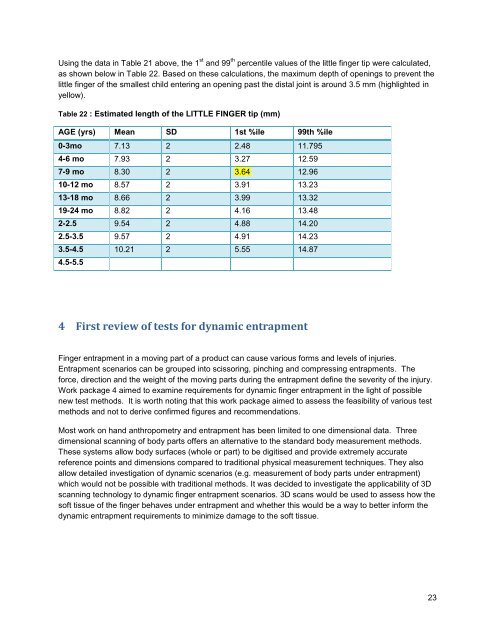Requirements for finger entrapment in European safety ... - ANEC
Requirements for finger entrapment in European safety ... - ANEC
Requirements for finger entrapment in European safety ... - ANEC
Create successful ePaper yourself
Turn your PDF publications into a flip-book with our unique Google optimized e-Paper software.
Us<strong>in</strong>g the data <strong>in</strong> Table 21 above, the 1 st and 99 th percentile values of the little <strong>f<strong>in</strong>ger</strong> tip were calculated,<br />
as shown below <strong>in</strong> Table 22. Based on these calculations, the maximum depth of open<strong>in</strong>gs to prevent the<br />
little <strong>f<strong>in</strong>ger</strong> of the smallest child enter<strong>in</strong>g an open<strong>in</strong>g past the distal jo<strong>in</strong>t is around 3.5 mm (highlighted <strong>in</strong><br />
yellow).<br />
Table 22 : Estimated length of the LITTLE FINGER tip (mm)<br />
AGE (yrs) Mean SD 1st %ile 99th %ile<br />
0-3mo 7.13 2 2.48 11.795<br />
4-6 mo 7.93 2 3.27 12.59<br />
7-9 mo 8.30 2 3.64 12.96<br />
10-12 mo 8.57 2 3.91 13.23<br />
13-18 mo 8.66 2 3.99 13.32<br />
19-24 mo 8.82 2 4.16 13.48<br />
2-2.5 9.54 2 4.88 14.20<br />
2.5-3.5 9.57 2 4.91 14.23<br />
3.5-4.5 10.21 2 5.55 14.87<br />
4.5-5.5<br />
4 First review of tests <strong>for</strong> dynamic <strong>entrapment</strong><br />
F<strong>in</strong>ger <strong>entrapment</strong> <strong>in</strong> a mov<strong>in</strong>g part of a product can cause various <strong>for</strong>ms and levels of <strong>in</strong>juries.<br />
Entrapment scenarios can be grouped <strong>in</strong>to scissor<strong>in</strong>g, p<strong>in</strong>ch<strong>in</strong>g and compress<strong>in</strong>g <strong>entrapment</strong>s. The<br />
<strong>for</strong>ce, direction and the weight of the mov<strong>in</strong>g parts dur<strong>in</strong>g the <strong>entrapment</strong> def<strong>in</strong>e the severity of the <strong>in</strong>jury.<br />
Work package 4 aimed to exam<strong>in</strong>e requirements <strong>for</strong> dynamic <strong>f<strong>in</strong>ger</strong> <strong>entrapment</strong> <strong>in</strong> the light of possible<br />
new test methods. It is worth not<strong>in</strong>g that this work package aimed to assess the feasibility of various test<br />
methods and not to derive confirmed figures and recommendations.<br />
Most work on hand anthropometry and <strong>entrapment</strong> has been limited to one dimensional data. Three<br />
dimensional scann<strong>in</strong>g of body parts offers an alternative to the standard body measurement methods.<br />
These systems allow body surfaces (whole or part) to be digitised and provide extremely accurate<br />
reference po<strong>in</strong>ts and dimensions compared to traditional physical measurement techniques. They also<br />
allow detailed <strong>in</strong>vestigation of dynamic scenarios (e.g. measurement of body parts under <strong>entrapment</strong>)<br />
which would not be possible with traditional methods. It was decided to <strong>in</strong>vestigate the applicability of 3D<br />
scann<strong>in</strong>g technology to dynamic <strong>f<strong>in</strong>ger</strong> <strong>entrapment</strong> scenarios. 3D scans would be used to assess how the<br />
soft tissue of the <strong>f<strong>in</strong>ger</strong> behaves under <strong>entrapment</strong> and whether this would be a way to better <strong>in</strong><strong>for</strong>m the<br />
dynamic <strong>entrapment</strong> requirements to m<strong>in</strong>imize damage to the soft tissue.<br />
23
















